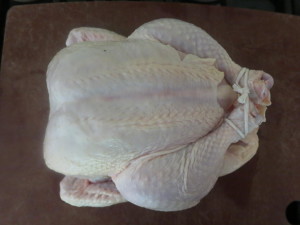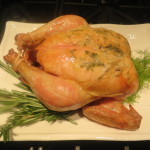Roasted Local Whole Chicken with Crispy Skin
There is nothing like a roasted chicken when the temperatures start to drop. The aromas fill your home with flavors that warm you to the bottom of your toes. I don’t know how many times I have cooked a whole chicken…many. But the challenge has always been getting the skin golden brown and crispy. I love to munch on that fabulous crispy skin so it’s always a disappointment when the chicken is moist & wonderful but the skin lacks that “I can’t wait, I have to take a nibble now!”.
For starters, it’s all about the chicken your cooking. The flavor of a local chicken is amazing. They’re raised without antibiotics & hormones by farmers who care about the health of their chickens. Feeding them a nutritious diet and giving them plenty of room to exercise leads to a healthier, firmer and tastier chicken.
The reason your chicken lacks that crispy skin is “Moisture”. Moisture on the chicken creates steam, which creates a softer skin. So, the trick is to get your chicken as dry as possible. Drying your chicken and refrigerating it for at least four hours or up to 24 hours will be the first step towards that perfect chicken.
We still want very moist chicken meat. To help maintain the moisture in the meat, separate the skin from the breast meat (this will assist in crisping the skin too) and rub a couple tablespoons of duck fat between the skin and the breast. No butter here, butter contains water – more moisture! I like to add some fresh herbs to the duck fat to add another layer of flavor. The final step before sending our chicken off to the frig is to season the outside with salt, just another step to absorb moisture from the skin. Give your chicken plenty of air space in the frig. Set your bird on a rack in a shallow baking pan, giving him lots of air space. Every star needs his space!
Now it’s show time! Give your bird time to rest at room temperature before you start cooking. Cooking at a high temperature will maximize the browning of the skin but we have to watch the internal temperature carefully to ensure we don’t overcook the chicken. It’s also important that we give our chicken plenty of air space while cooking. Do not cook your chicken in a pan that has higher edges. This will lead to more moisture and will create steam. Chicken is fully and safely cooked when it reaches 165 degrees. You’ll want to remove the chicken at 160 degrees, the temperature will rise to 165 degrees while it’s resting.
I like to serve this with Roasted Garlic Smashed Potatoes and Roasted Brussel Sprouts. Before roasting the chicken: I roast the garlic, wash my potatoes and get them in a pot of salted cold water and prep my brussel sprouts. The brussel sprouts can roast with the chicken and the potatoes can start boiling at the same time. Create the smashed potatoes while everything else is cooking and keep warm till it’s time to serve. Enjoy!!!
Roasted Local Whole Chicken with Crispy Skin
Ingredients
- 3 lb Whole Chicken
- 1 tablespoon Duck Fat
- 1 tablespoon fresh thyme
- Sea Salt
Instructions
- Rinse chicken in cold water and dry with paper towel (inside and outside). To keep the chicken cooking evenly, you’ll need to flip the wing tips under the chicken and tie the legs together. You can also cut a small hole in the skin next to the end of the drumstick. Insert the drumstick tip through the hole.

- Disconnect the breast meat from the skin by gently rubbing your fingers between the breast and the skin. Rub duck fat and thyme between the breast meat and skin. Season with salt. Place your chicken on a rack in a shallow baking dish. Refrigerate for four to 24 hours.
- Preheat oven to 425 degrees. Let your chicken rest for 30 minutes at room temperature. Bake until your chicken reaches a temperature of 160 degrees, internal temperature will rise to 165 degrees while it rests. This will take 45 minutes to an hour.


